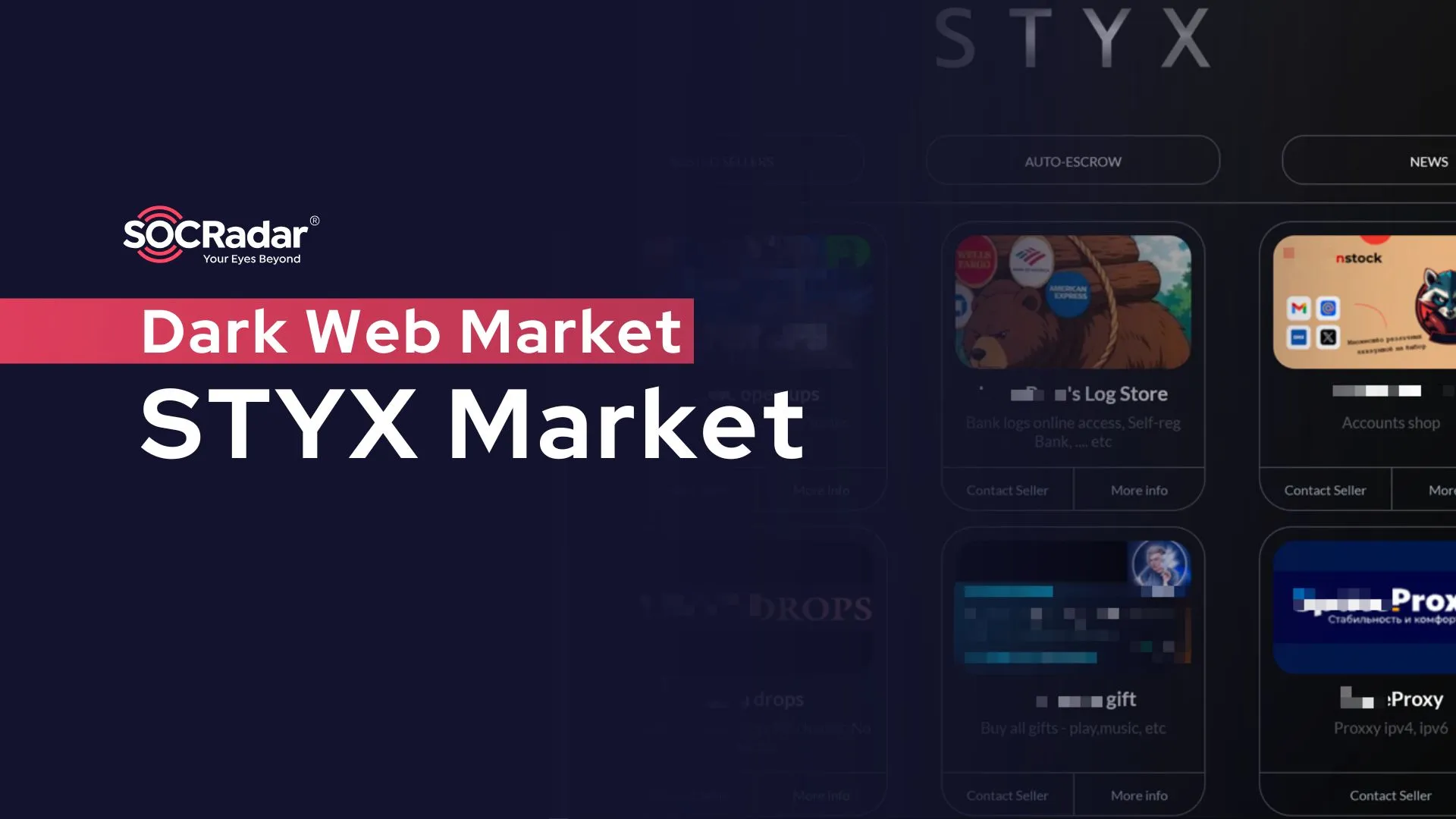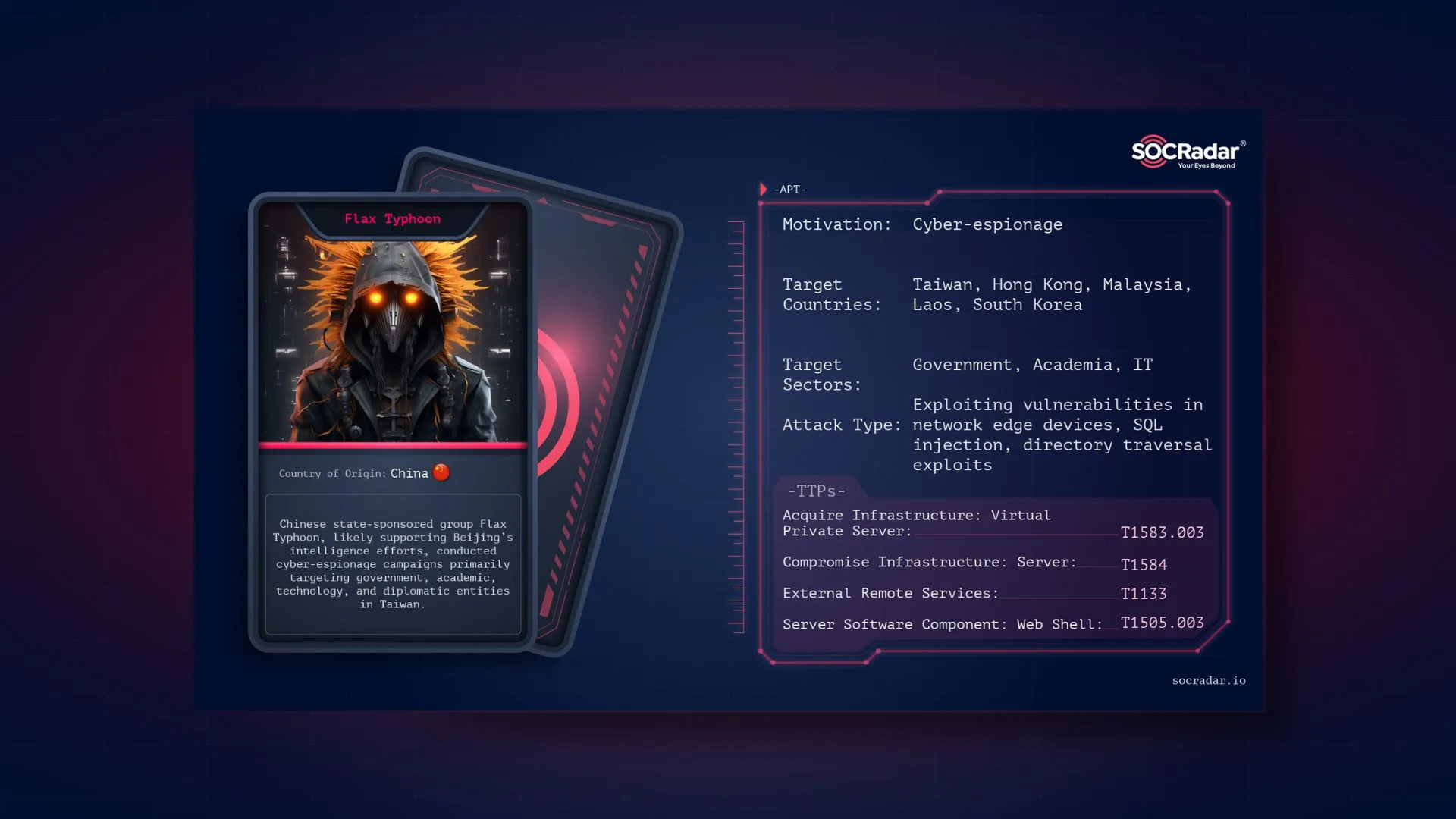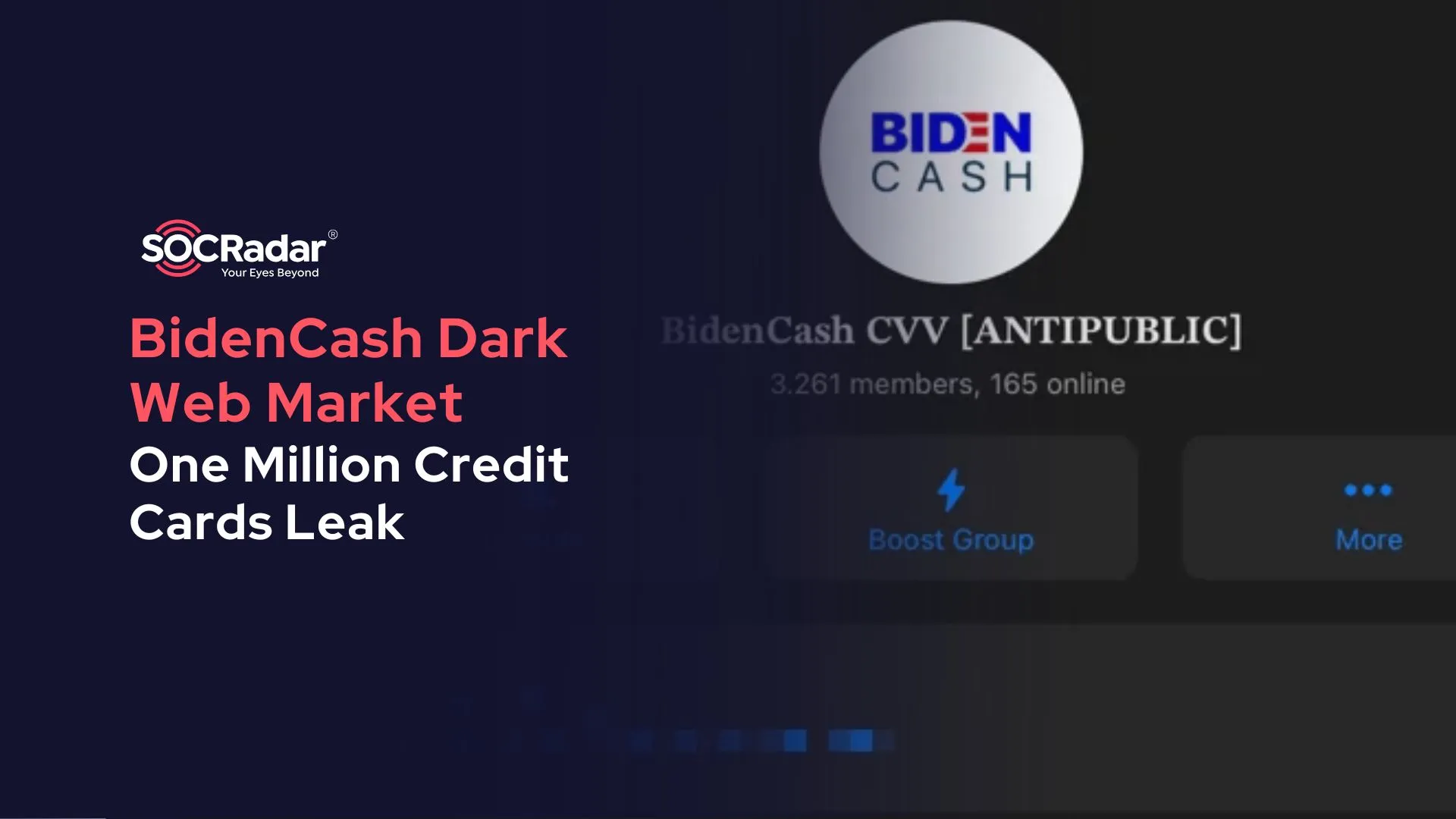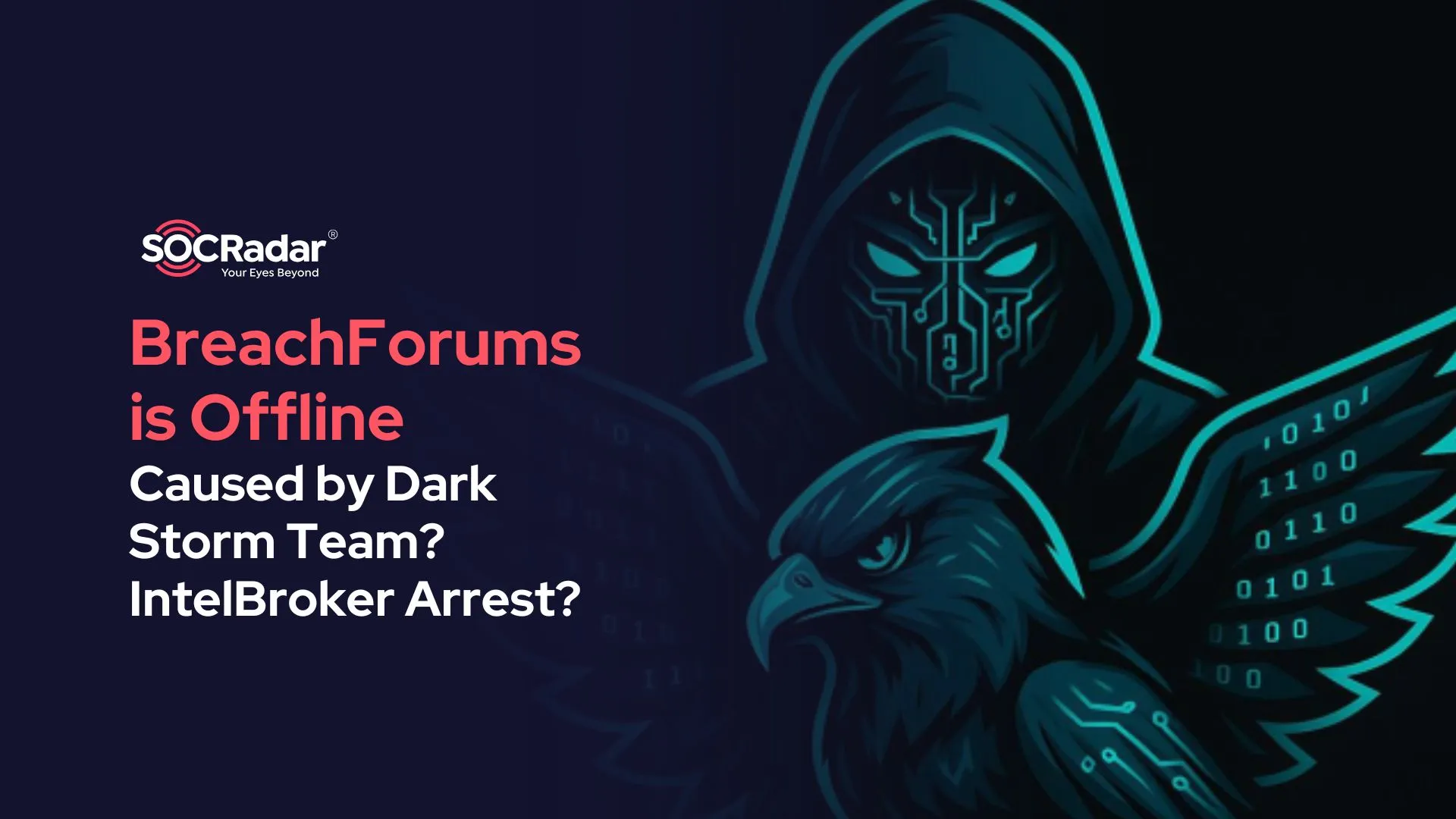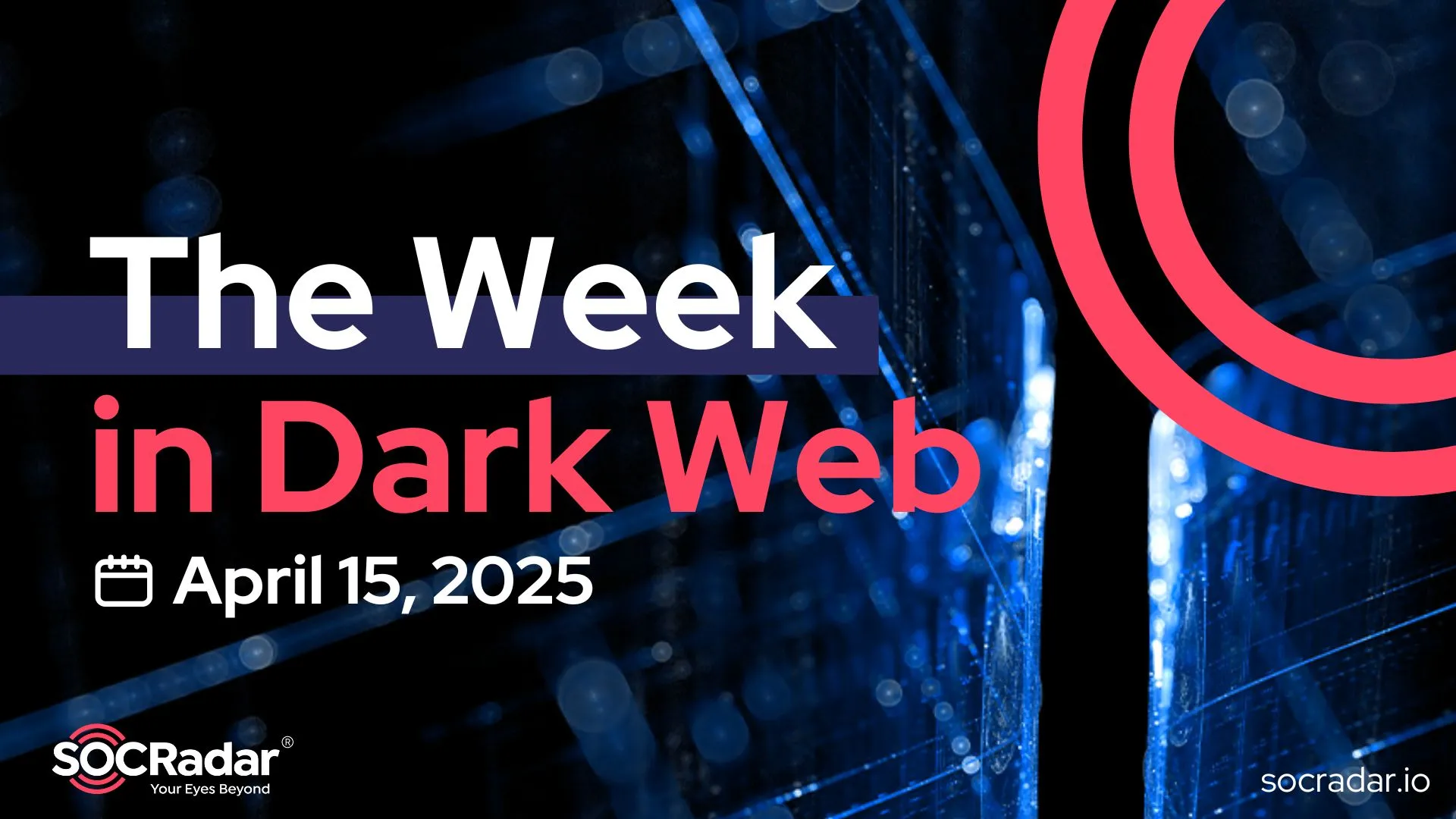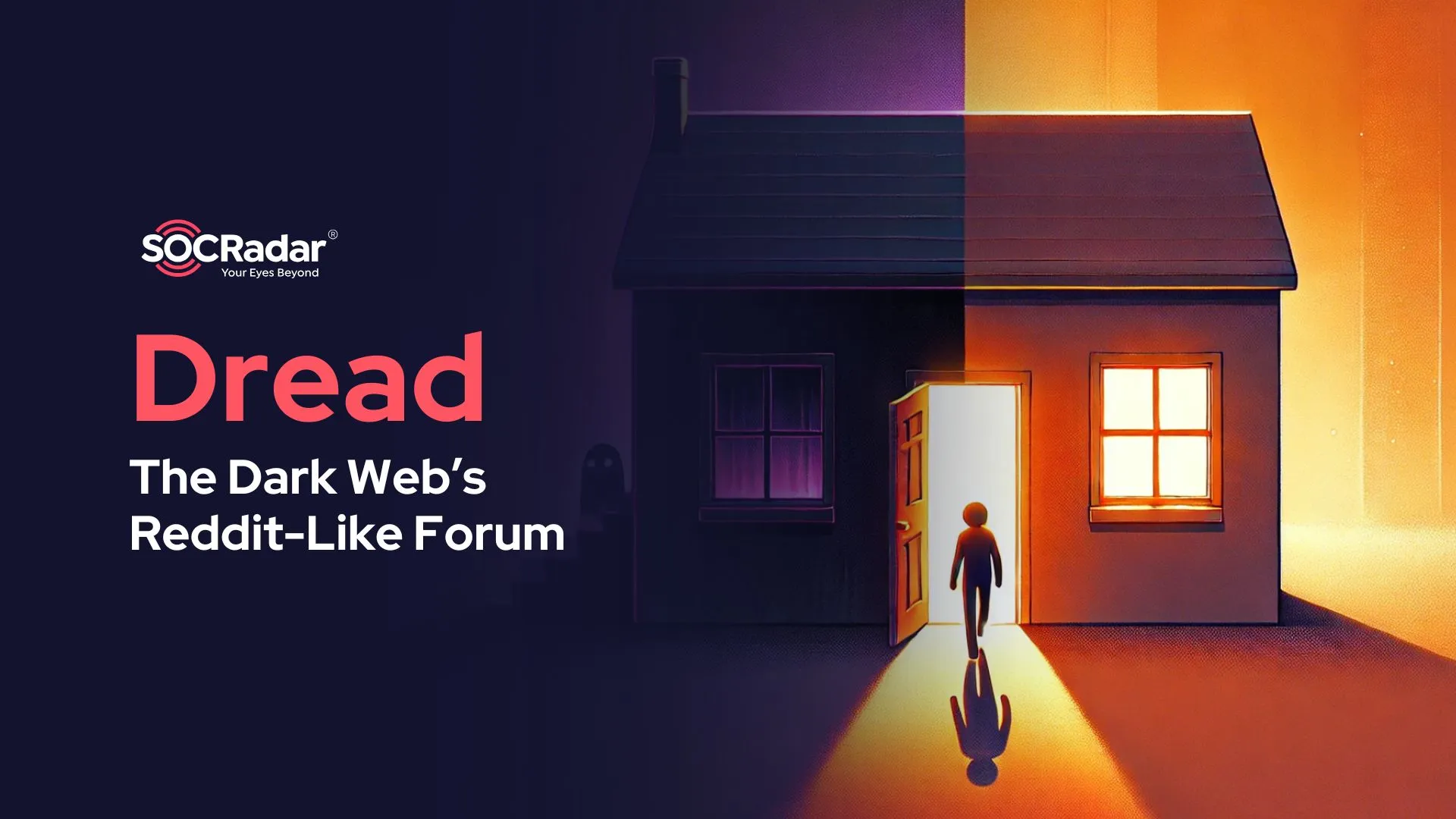
Dread: The Dark Web’s Reddit-Like Forum
Dark web forums are crucial gathering points for cybercriminals, facilitating illegal trade, data breaches, and financial fraud. According to SOCRadar’s Annual Dark Web Report 2024, a vast amount of cybercrime activity is orchestrated through these platforms. Last year alone, over 1 million email-password credentials were compromised, alongside 337,745 password hashes and 75,163 stolen credit card details.

A figure enters a dark, eerie house, symbolizing the transition from Reddit to Dread. (Generated by DALL-E)
Among the most active hubs for these underground activities is Dread, a Reddit-like dark web forum where cybercriminals coordinate attacks, share exploits, and leak sensitive data. Discussions on ransomware operations, darknet market shutdowns, and stolen credentials make Dread a focal point for both threat actors and cybersecurity researchers. Examining this forum offers valuable insights into the evolving threat landscape, helping organizations anticipate and mitigate potential cyber risks.
What is Dread Forum?
Dread is a well-known forum on the dark web, designed to function like Reddit. It primarily serves as a discussion platform for topics related to darknet markets, ransomware, cybersecurity, and online privacy. Created in 2018 by an anonymous administrator called HugBunter, Dread quickly gained popularity as a key space for users to share information and insights on underground activities. The forum was developed as an alternative to Reddit after the platform banned discussions related to darknet markets and security issues, prompting the need for a more privacy-focused alternative.
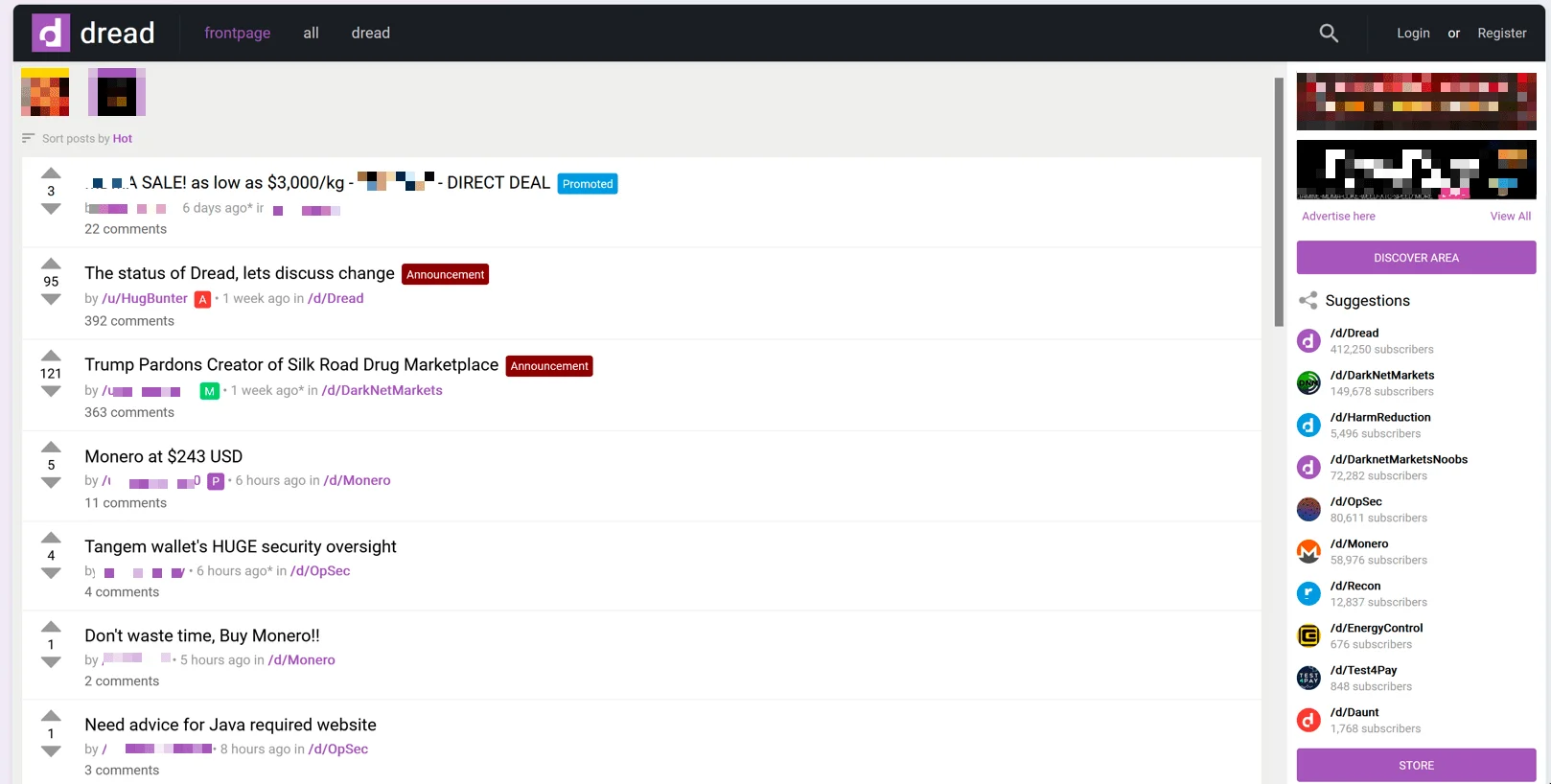
A screenshot of the Dread forum homepage.
Disclaimer: This blog does not provide instructions on how to access the Dread forum. Instead, it aims to outline the forum’s main features and highlight the dangers and legal consequences associated with the dark web. Engaging in illegal activities on the dark web can result in severe criminal charges.
How Dread Works: Structure, Features, and Security Measures
Dread operates as a decentralized forum on the dark web, often compared to Reddit due to its structure. However, unlike mainstream platforms, it is designed with a strong emphasis on anonymity and security, making it a haven for discussions about darknet markets, privacy tools, and cyber threats. Users can participate in various “subdreads,” which function as topic-specific discussion boards. These allow members to share insights, ask questions, and discuss emerging trends in the darknet landscape.
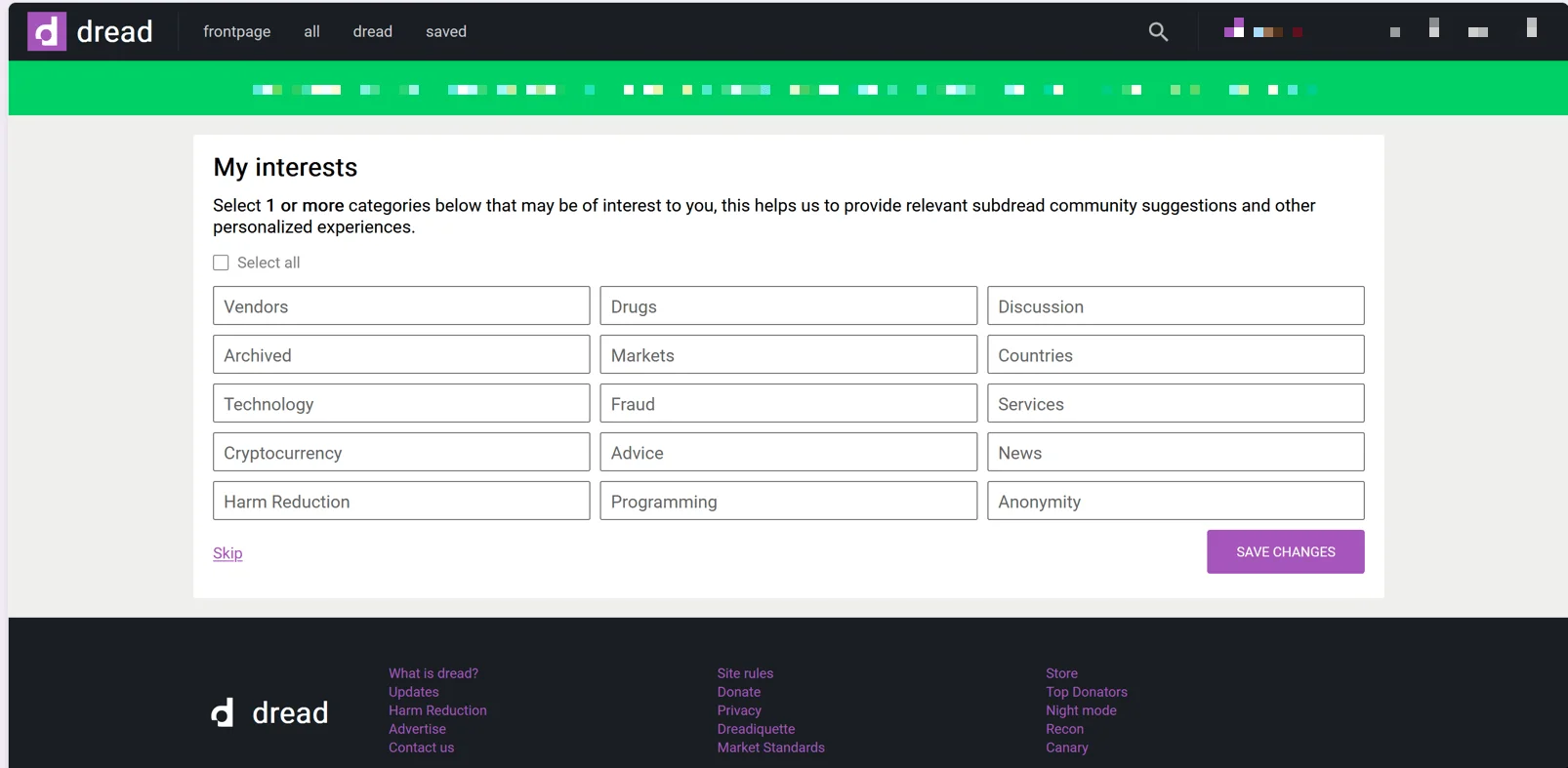
Dread forum’s My Interests selection page, allowing users to customize their experience by choosing discussion categories.
One of the unique aspects of Dread is its personalized user experience, which begins during the registration process. New users are prompted to select their areas of interest from a range of categories, including cybersecurity, programming, cryptocurrency, fraud, darknet markets, and harm reduction. This feature helps tailor the forum experience by recommending relevant subdreads based on user preferences. By allowing users to customize their feeds, Dread enhances engagement while ensuring that discussions remain focused on topics of individual interest.
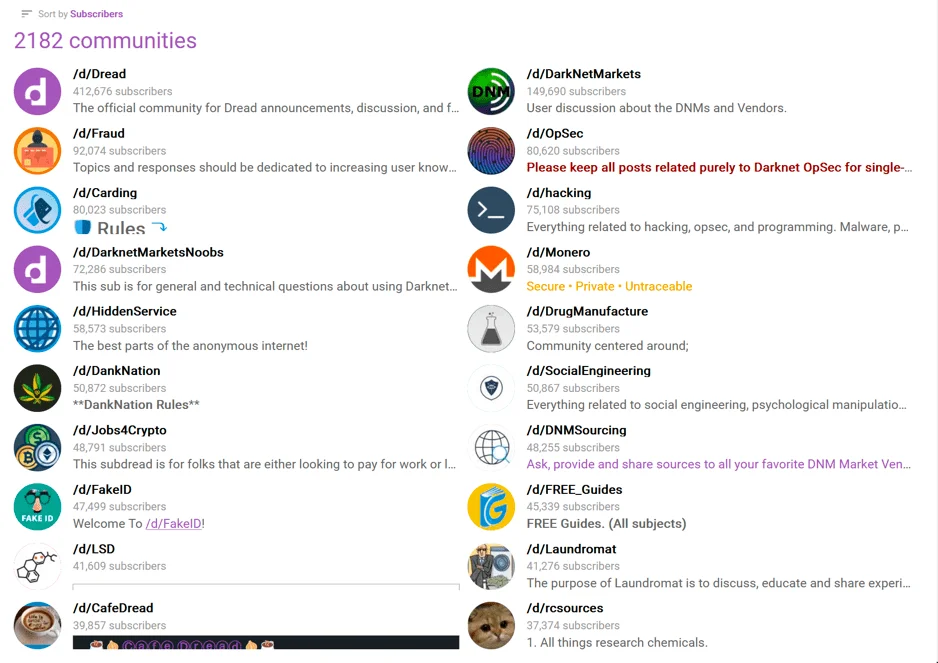
The most active sub-forums on Dread.
This interest-based system also highlights the diversity of discussions taking place on Dread. While some subdreads focus on legitimate cybersecurity practices and privacy tools, others delve into illicit activities such as fraud and drug markets. The ability to choose specific topics allows users to either stay within legally acceptable areas or explore the more controversial aspects of the darknet. This structure further reinforces the importance of anonymity and operational security (OpSec) within the forum, as users must be mindful of the risks associated with engaging in certain discussions.
Some key features that set Dread apart include:
- Decentralized Community Management: Users create and moderate their own subdreads, setting rules and discussion topics, similar to Reddit but without corporate oversight.
- Robust Anonymity Protections: Built exclusively on the Tor network, Dread ensures complete user privacy, preventing IP tracking and identity exposure.
- User-Governed Moderation: Each subdread has designated moderators who oversee discussions, enforce guidelines, and manage content.
- Advanced Security Infrastructure: To withstand persistent cyber threats, including DDoS attacks, Dread employs sophisticated protective measures such as the EndGame-DDOS-protection system and routine security audits.
This structure has helped Dread become a vital platform for darknet users, fostering a highly engaged and self-regulated community. While it provides valuable insights for cybersecurity researchers, it also serves as a platform for illicit activities, raising concerns about its role in the broader darknet ecosystem.
SOCRadar Threat Hunting: Mastering Dark Web Threat Intelligence
The dark web is a vast, unregulated space where cybercriminals, researchers, and privacy advocates converge. Forums like Dread serve as hubs for darknet activities, but navigating this chaotic landscape requires specialized tools. This is where threat intelligence solutions play a crucial role.
If Dread is the Reddit of the dark web, SOCRadar’s Threat Hunting module is the intelligence tool that cuts through the noise—unveiling threats before they escalate. While traditional cybersecurity focuses on reacting to detected risks, proactive defense is essential to staying ahead of evolving threats.
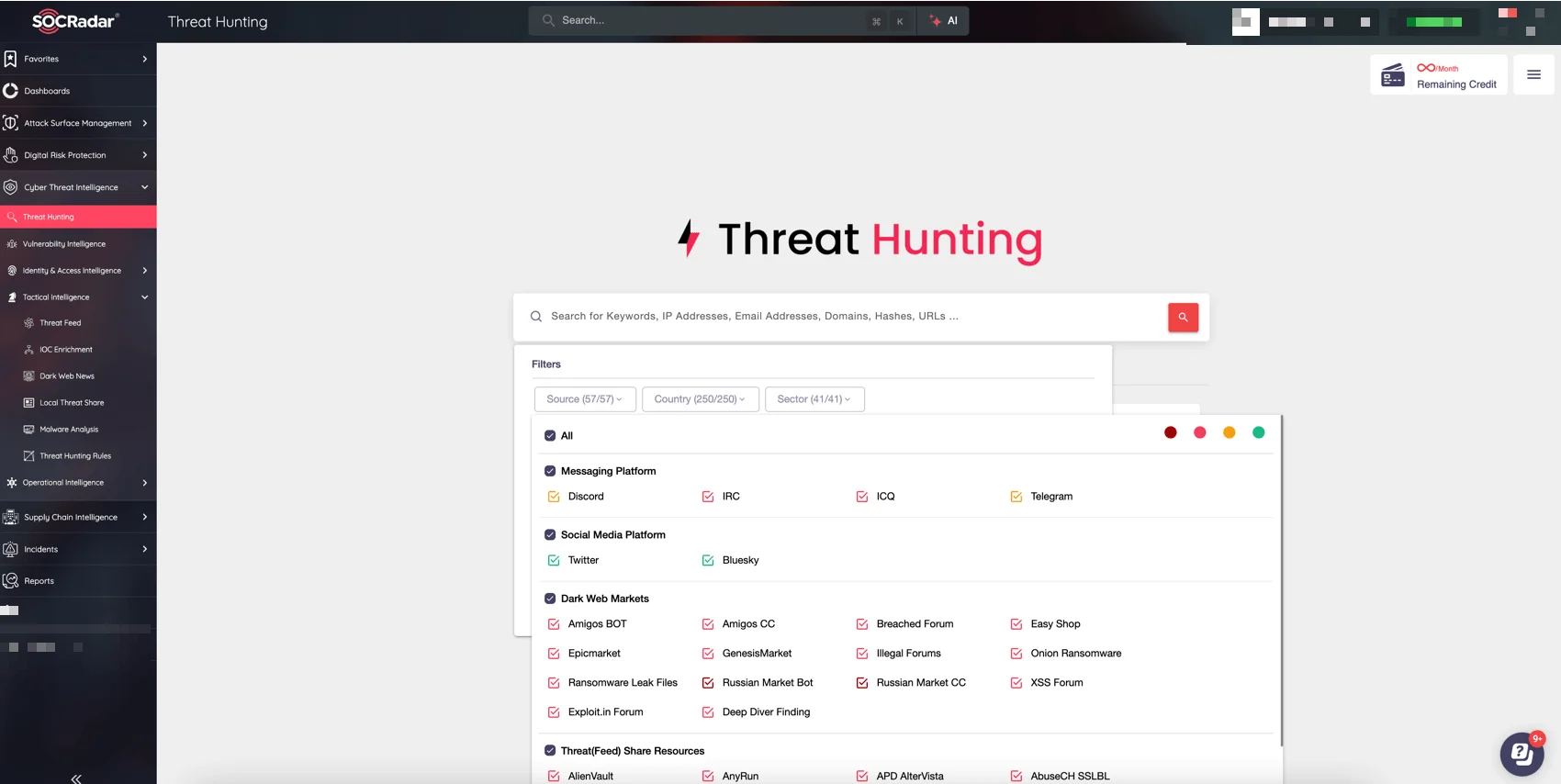
SOCRadar Threat Hunting module.
SOCRadar’s Threat Hunting module scours hidden forums, marketplaces, and encrypted channels, identifying potential risks before they become full-scale attacks. By leveraging advanced filtering and search technologies, it extracts meaningful intelligence from vast dark web data, providing actionable insights.
Just as Google indexes and ranks online information, SOCRadar systematically analyzes dark web trends, conversations, and anomalies. From leaked credentials to cybercriminal chatter on upcoming exploits, SOCRadar transforms fragmented data into a strategic defense against emerging threats.
History and Notable Events on Dread
Since its launch in 2018, Dread has undergone significant transformations, shaped by key events that have defined its role in the darknet community. As a central hub for discussions on illicit markets, cybersecurity, and online anonymity, the forum has also faced controversies, security challenges, and technical setbacks. Below are some of the most notable incidents in its history.
- 2019 Downtime and Security Concerns: In September 2019, Dread’s administrator, HugBunter, mysteriously disappeared, triggering a dead man’s switch that alarmed the darknet community. Speculation ranged from law enforcement intervention to internal disputes. After weeks of uncertainty, HugBunter resurfaced in November, revealing that a server failure had caused the outage. In response, the platform was restructured with enhanced security and a redesigned interface to prevent similar disruptions.
- DDoS Attacks and Cyber Warfare: As one of the dark web’s most influential discussion forums, Dread has been a frequent target of cyberattacks. Rival hacker groups, marketplace operators, and even state-sponsored actors have launched sustained DDoS attacks, attempting to disrupt its accessibility. Some of these attacks exploited vulnerabilities in the Tor network, causing prolonged downtimes and forcing administrators to implement stronger defenses. Many of these attacks have been linked to rival darknet communities and marketplace disputes, with adversaries seeking to undermine competing platforms.
- Forum Influence on Market Dynamics: Dread has played a pivotal role in shaping the darknet marketplace ecosystem. The forum has been at the center of discussions surrounding major marketplace shutdowns, including the fall of Dream Market and AlphaBay’s successors. Vendors and buyers rely on it to review markets, expose scams, and share security strategies. It has also been instrumental in leaking sensitive information about compromised marketplaces, sometimes accelerating their downfall. Discussions on exit scams, law enforcement crackdowns, and emerging threats often originate or gain traction within the forum.
Despite these challenges, Dread remains a cornerstone of the dark web ecosystem, influencing market trends and providing an anonymous platform for discussions on cybersecurity, privacy, and illicit activities
Dread’s Influence and the Future of Dark Web Forums
Dread has played a controversial role in the dark web ecosystem, influencing market trends, facilitating discussions on illicit activities, and serving as a hub where cybercriminals, researchers, and privacy advocates intersect. While some use it to exchange information on digital privacy and cybersecurity, others exploit it to engage in fraud, hacking, and other illegal operations.
Role in Darknet Markets and Ransomware Operations
Dread is frequently used as a platform for darknet market discussions, vendor reviews, and scam warnings. However, it has also become a meeting point for ransomware operators. Groups leveraging the Ransomware-as-a-Service (RaaS) model use the forum to recruit affiliates, share attack techniques, and announce data leaks from compromised companies. The forum enables coordination between cybercriminal groups, allowing them to exchange tools, discuss exploits, and strategize attacks. Additionally, discussions often include leaked database sales and credential dumps, making it a resource for both cybercriminals and threat intelligence analysts attempting to track illegal activities.
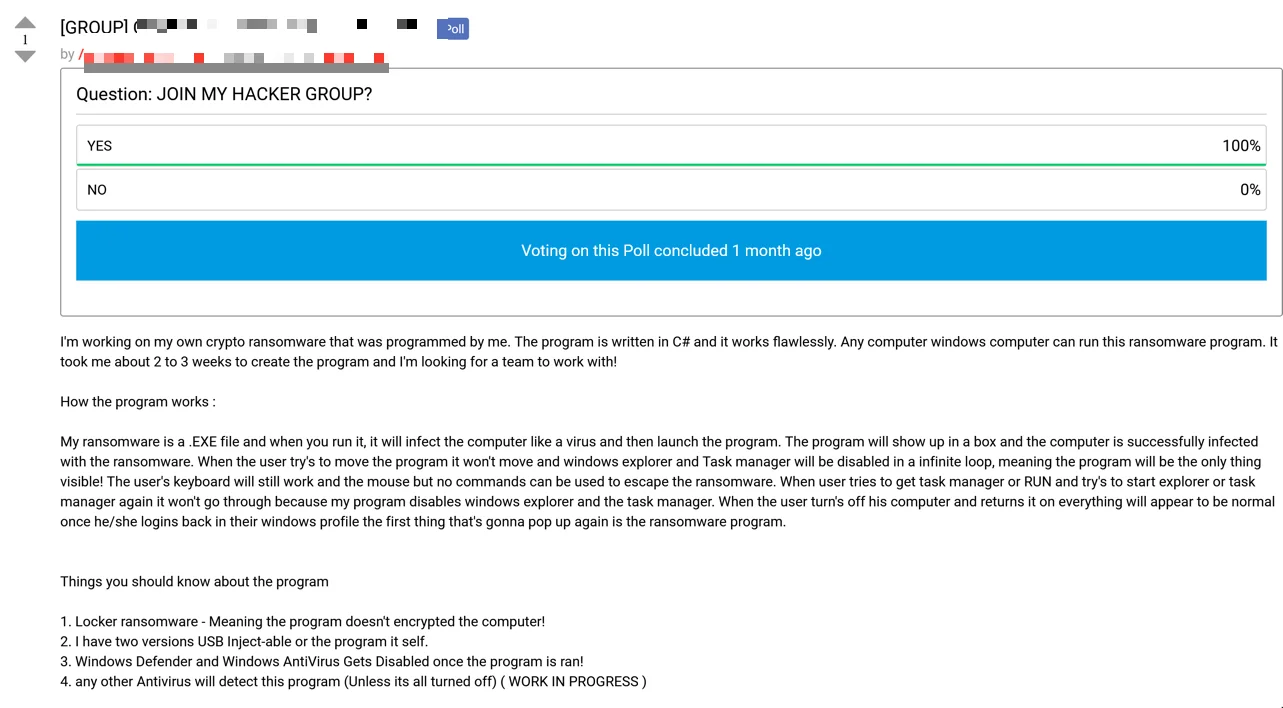
Poll post on Dread forum inviting members to join a ransomware development group, detailing the functionality of a custom ransomware written in C#.
Users on Dread can even uncover information about why a darknet market was shut down, whether administrators disappeared with users’ funds in an exit scam, or if law enforcement took action against a marketplace. These discussions provide real-time insights into the shifting dynamics of cybercrime and darknet operations.
Challenges and the Future of Dark Web Forums
Despite its widespread use, Dread faces growing challenges. Continuous DDoS attacks, law enforcement scrutiny, and internal conflicts within the darknet community pose constant threats to its stability. While its administrators have implemented countermeasures to maintain uptime, adversarial forces—including rival darknet groups and authorities—continue efforts to disrupt its operations.
Future dark web forums may evolve toward decentralized, blockchain-based models to enhance resilience against external pressures. As cybersecurity measures advance, darknet operators will likely adopt more sophisticated anonymization methods to counter digital forensics and tracking efforts. Whether Dread continues to thrive or is replaced by newer, more resilient alternatives, its role in shaping the darknet’s future remains undeniable—albeit as a double-edged sword, used for both information-sharing and criminal enterprises.
Strengthening Cyber Defense with SOCRadar’s Advanced Dark Web Monitoring
As dark web forums like Dread continue to facilitate illicit activities, organizations must stay ahead of emerging threats. SOCRadar’s Advanced Dark Web Monitoring equips security teams with real-time intelligence, offering visibility into underground activities that could impact businesses and individuals.
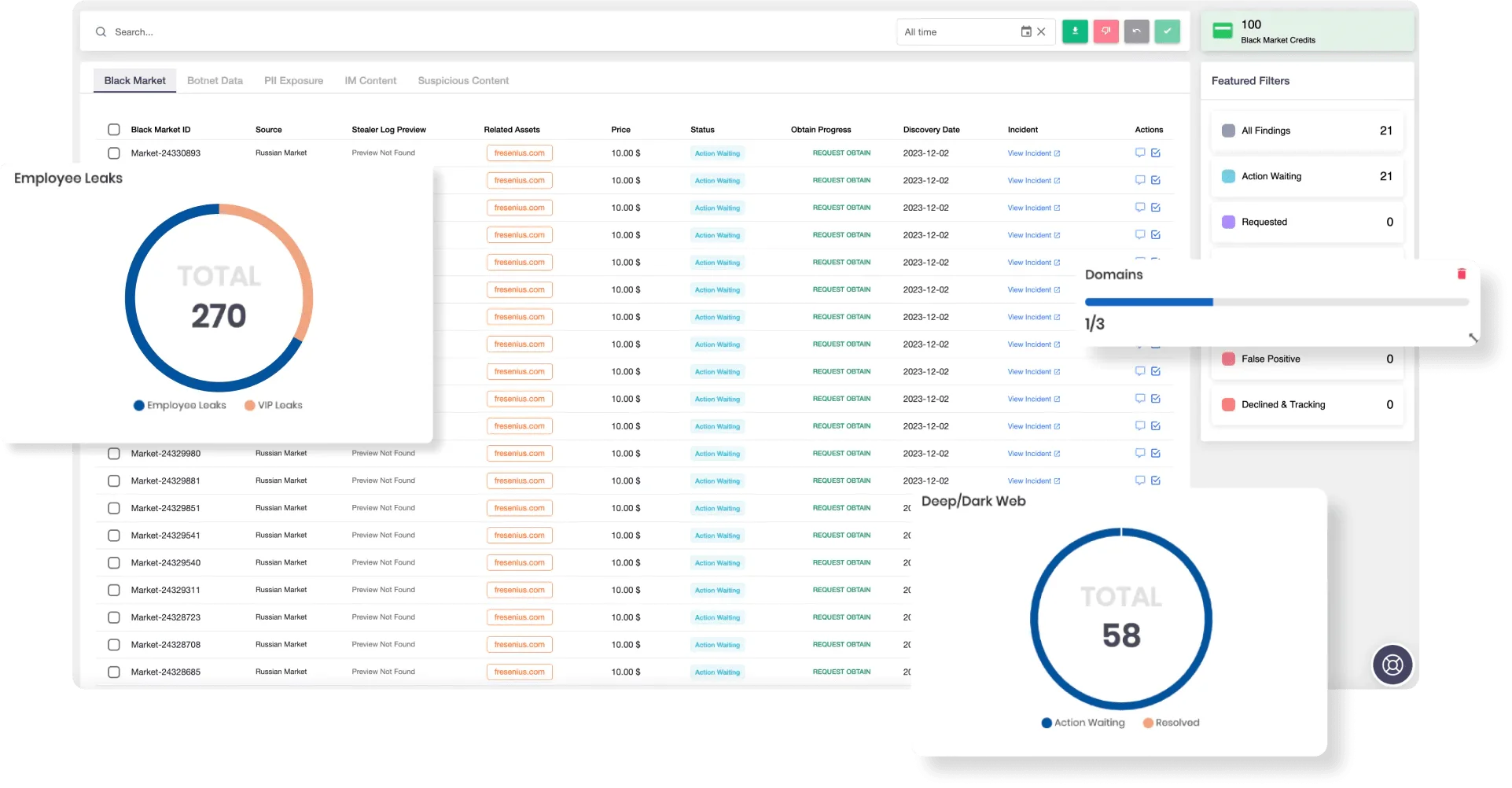
SOCRadar Dark Web Monitoring
- Early Threat Detection: Monitors deep, dark, and surface web sources to identify threats before they escalate.
- Fraud Prevention: Detects stolen credentials, credit card data, and financial scams to mitigate fraud risks.
- Executive Protection: Shields high-profile individuals from identity theft and targeted cyberattacks.
- Dark Web Intelligence Search: Provides a robust tool to track stealer logs, cybercriminal discussions, and hidden threats.
With SOCRadar’s Advanced Dark Web Monitoring, organizations can proactively track cybercriminal activities, reduce risk exposure, and respond swiftly to potential security incidents before they escalate.
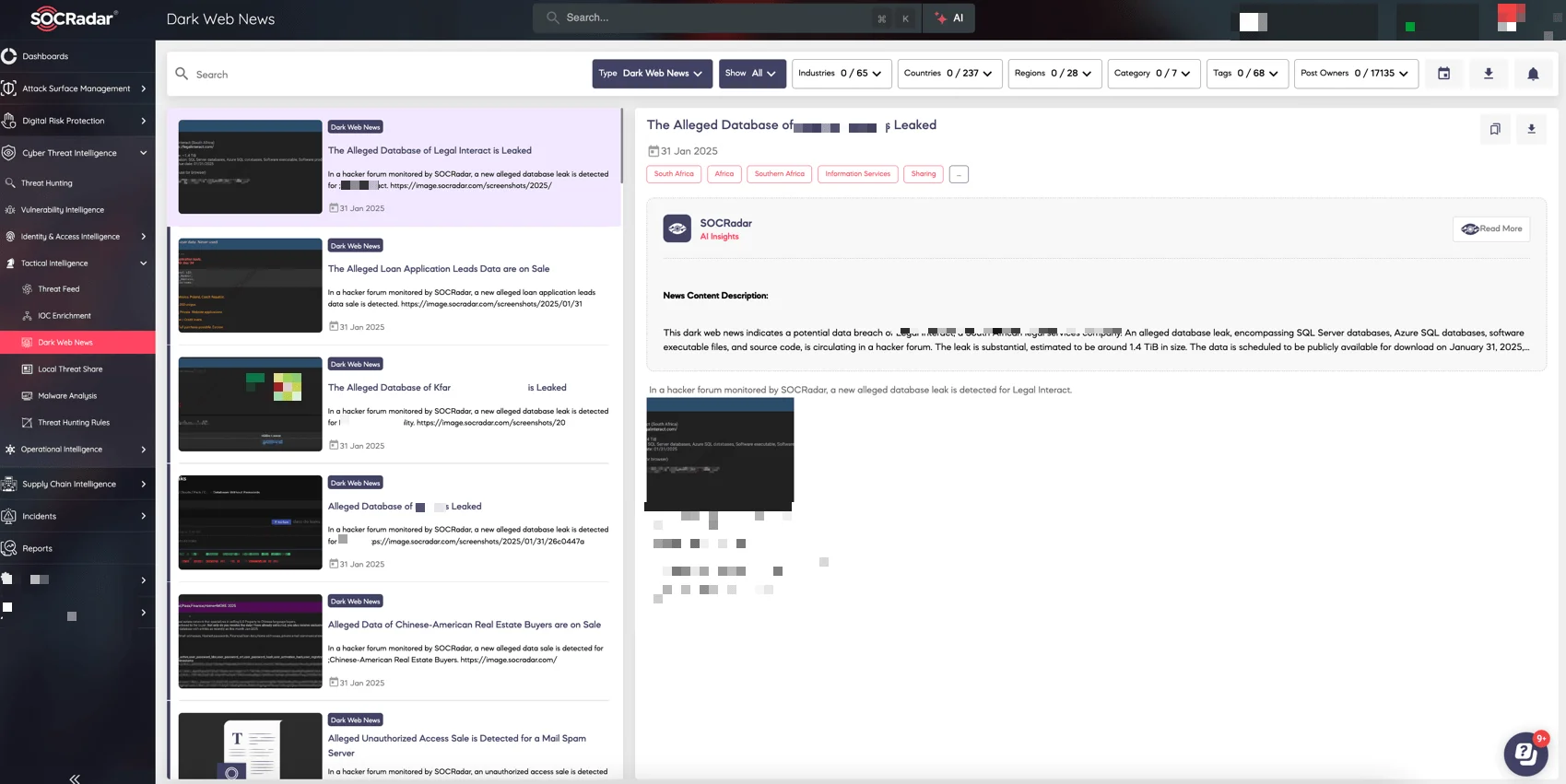
SOCRadar Dark Web News
Additionally, SOCRadar’s Dark Web News feature keeps security teams informed of the latest discussions from deep and dark web forums, including hacker networks like Telegram, providing valuable insights into evolving cyber threats.. SOCRadar’s Advanced Dark Web Monitoring provides a proactive defense mechanism by tracking leaked credentials, financial fraud schemes, and cybercriminal activities in real-time.






























